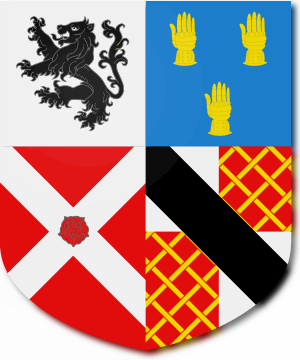Sir William Stapleton, 1st Baronet facts for kids
Quick facts for kids
Sir William Stapleton, Bt
|
|
|---|---|
 |
|
| Governor of the Leeward Islands | |
| In office 1671–1686 |
|
| Monarch | Charles II |
| Preceded by | Office established |
| Succeeded by | Nathaniel Johnson |
| Personal details | |
| Born | Unknown Ireland |
| Died | 3 August 1686 Paris, France |
| Spouse | Anne Russell (m. 1671) |
| Children | James, William, Miles, and Mary |
| Military service | |
| Allegiance | |
| Branch/service | |
Sir William Stapleton, 1st Baronet (born at an unknown date – died August 3, 1686) was an important official and landowner from Ireland. He served as the governor of the Leeward Islands from 1671 until he passed away in 1686. William was born in Ireland into a family with Norman roots. During a time of civil war in England, he supported King Charles II. When Charles II had to leave England, William went with him to France.
After Charles II returned to England in 1660, William also came back. He became an officer in the English Army. He then traveled to England's colonies in the British West Indies. There, he became a key government official. He also married into a wealthy family that owned large farms. William himself acquired several large farms before he died in Paris in 1686.
Contents
Who Was Sir William Stapleton?
William Stapleton was the third son of Redmond Stapleton. He was born in Ireland. His family believed they were descended from a Norman knight. This knight had settled in Ireland during the time of King Henry II.
Early Life and Royal Connections
During the Wars of the Three Kingdoms, William was a Royalist. This meant he supported the king. He followed King Charles II into exile in France. In 1660, Charles II returned to England. This event was called the Stuart Restoration. William followed him back. This opened up new chances for him in England's colonies. These colonies were located in the British West Indies.
Journey to the West Indies
In 1667, William Stapleton was an officer in the English Army. He sailed to Barbados with Sir Tobias Bridge. There, William was given the rank of lieutenant colonel. The governor of Barbados, Lord Willoughby, sent him to the Leeward Islands.
The next year, he became the Deputy Governor of Montserrat. In 1671, William made history. He became the very first governor of the Leeward Islands. In the same year, he married Anne Russell. She was the daughter of Colonel Randolph Russell. Colonel Russell was a military officer and owned a large farm in Nevis. This marriage connected William to many important families in the area.
Life as a Governor and Landowner
During his time in the West Indies, William gained several large farms. One was the "Waterwork" farm in Montserrat. Another was the "Cayon Quarter" farm on Saint Kitts. This farm was a gift to William from Philip de Nogle. He also owned the "Figtree" farm in Nevis. And he had the "Carleton" farms on Antigua.
In 1678, William gave the "Figtree" farm to Charles Pim. He did this on behalf of the King. But William quickly bought it back. He paid 400,000 pounds of muscovado sugar for it. In 1679, the "Carleton" farms were given to his older brother, Redmond. Three years later, William bought them from Redmond. He paid 100,000 pounds of muscovado sugar.
Becoming a Baronet and His Legacy
On December 20, 1679, William received a special honor. The King made him a baronet. This meant he was given the title of "Sir" and his family could pass it down. This title was called the Stapleton baronetcy. The title ended in 1995. This was because the 10th baronet had no male children to inherit it.
William passed away in Paris in 1686. He left behind some complex financial matters. His sons who survived him were James, William, and Miles. James became the 2nd Baronet but died young. The baronetcy then went to his second son, William, who became the 3rd Baronet. William also had a daughter named Mary. She married an Irish official named Sir James Fitz Edmond Cotter.

